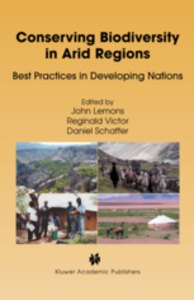The domestication of indigenous trees as the basis of a strategy for sustainable land use
Leakey, R.R.B. (2003) The domestication of indigenous trees as the basis of a strategy for sustainable land use. In: Lemons, John, Victor, Reginald, and Schaffer, Daniel, (eds.) Conserving Biodiversity in Arid Regions: best practices in developing nations. Kluwer Academic Publishers, Dordrecht, the Netherlands, pp. 27-40.
|
PDF (Published Version)
- Published Version
Restricted to Repository staff only |
||
![[img]](https://researchonline.jcu.edu.au/7332/2.hassmallThumbnailVersion/7332_Leakey_2003_Book_Cover.jpg)
|
Image (JPEG) (Book Cover)
- Cover Image
Download (66kB) |
Abstract
The sustainability of land use in the tropics has typically been lost when species-rich natural vegetation has been cleared to make way for monocultures of improved staple food crops grown intensively with high inputs of agrochemicals. These intensive fanning systems have indeed helped to feed growing human populations, but at an environment cost that cannot be tolerated into the future. One suggestion for an acceptable alternative that both feeds the people and restores some of the diversity found in natural vegetation, is the development of lower input agroecosystems that combine the cultivation of 'Green Revolution' staple food crops with a number of the indigenous food producing tree species that can restore ecosystem function. This return towards more traditional land use practices can be enhanced by the judicious development of high quality, high yielding cultivars of the trees through the adaptation of standard horticultural practices, and planting of these cultivars in agroforests. In dryland Africa, there are many traditionally important tree species producing marketable nontimber forest products, which have potential to be domesticated in this way. The techniques, methodologies and strategies exist and are being implemented in a small way. A few species are already being domesticated with the participation of local communities. There is the potential to expand these programmes to a scale where they can start to have meaningful impact on land use and create new more biologically diverse, functioning agroecosystems, which also support and enhance the livelihoods of local people. This would be a good example of "Promoting Best Practices for Conservation and Sustainable Use of Biodiversity of Global Significance in Arid and Semi-arid Zones".
| Item ID: | 7332 |
|---|---|
| Item Type: | Book Chapter (Research - B1) |
| ISBN: | 978-1-4020-7483-7 |
| Date Deposited: | 18 Jan 2010 23:26 |
| FoR Codes: | 07 AGRICULTURAL AND VETERINARY SCIENCES > 0799 Other Agricultural and Veterinary Sciences > 079999 Agricultural and Veterinary Sciences not elsewhere classified @ 100% |
| SEO Codes: | 82 PLANT PRODUCTION AND PLANT PRIMARY PRODUCTS > 8202 Horticultural Crops > 820214 Tropical Fruit @ 51% 82 PLANT PRODUCTION AND PLANT PRIMARY PRODUCTS > 8202 Horticultural Crops > 820299 Horticultural Crops not elsewhere classified @ 49% |
| Downloads: |
Total: 222 Last 12 Months: 1 |
| More Statistics |



